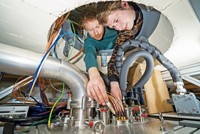Advertisement
Grab your lab coat. Let's get started
Welcome!
Welcome!
Create an account below to get 6 C&EN articles per month, receive newsletters and more - all free.
It seems this is your first time logging in online. Please enter the following information to continue.
As an ACS member you automatically get access to this site. All we need is few more details to create your reading experience.
Not you? Sign in with a different account.
Not you? Sign in with a different account.
ERROR 1
ERROR 1
ERROR 2
ERROR 2
ERROR 2
ERROR 2
ERROR 2
Password and Confirm password must match.
If you have an ACS member number, please enter it here so we can link this account to your membership. (optional)
ERROR 2
ACS values your privacy. By submitting your information, you are gaining access to C&EN and subscribing to our weekly newsletter. We use the information you provide to make your reading experience better, and we will never sell your data to third party members.
Materials
Atom-sized Quantum Dots
Newly discovered property of silicon atoms may shrink computers
by Mitch Jacoby
February 5, 2009
INDIVIDUAL SILICON ATOMS can exhibit electronic properties typical of quantum dots composed of thousands of atoms, according to researchers at Canada's National Institute for Nanotechnology and the University of Alberta, Edmonton (Phys. Rev. Lett. 2009, 102, 046805). The discovery of atom-sized quantum dots and the associated room-temperature control over individual electrons may lead to a new type of circuitry that drives miniature, low-power computers.
Semiconductor nanocrystals are often called quantum dots because, among other reasons, their electronic energy levels are quantized and discrete—like an atom's. Researchers are studying that property, which ties the color of colloidal nanocrystals to their size for applications such as computing. The idea is to use the electronic states of quantum dots, which are far smaller than today's transistors, to represent the zeros and ones of digital processing.
At present, the working material for that research thrust is some the smallest quantum dots readily available—crystals of about 1,000 atoms. But to use them for computations, researchers must chill the nanocrystals to millikelvin temperatures to prevent them from flipping spontaneously between electronic states. The Edmonton team, led by Robert A. Wolkow, has discovered a way to sidestep those limitations.

Using a scanning tunneling microscope to probe hydrogen-blanketed silicon, the group showed that kicking out a hydrogen atom bonded to silicon results in a negatively charged Si atom that behaves like a quantum dot. Kicking out another nearby hydrogen leads to an artificial Si2 molecule with one electron shuttling between the two atoms (similar to H2+). Then by using a large charge, the team showed that this "bonding" electron can be pins at will, thereby locking the quantum dot into a given electronic state that remains stable even at room temperature.
"These results are remarkable," says Craig S. Lent, professor of electrical engineering at the University of Notre Dame. Wolkow's group has demonstrated a new binary switching mechanism that operates at room temperature and at a truly atomic size scale, he explains. Lent adds "The world is looking for a new binary switch to replace the transistor when size scaling ends. This just might be it."




Join the conversation
Contact the reporter
Submit a Letter to the Editor for publication
Engage with us on Twitter